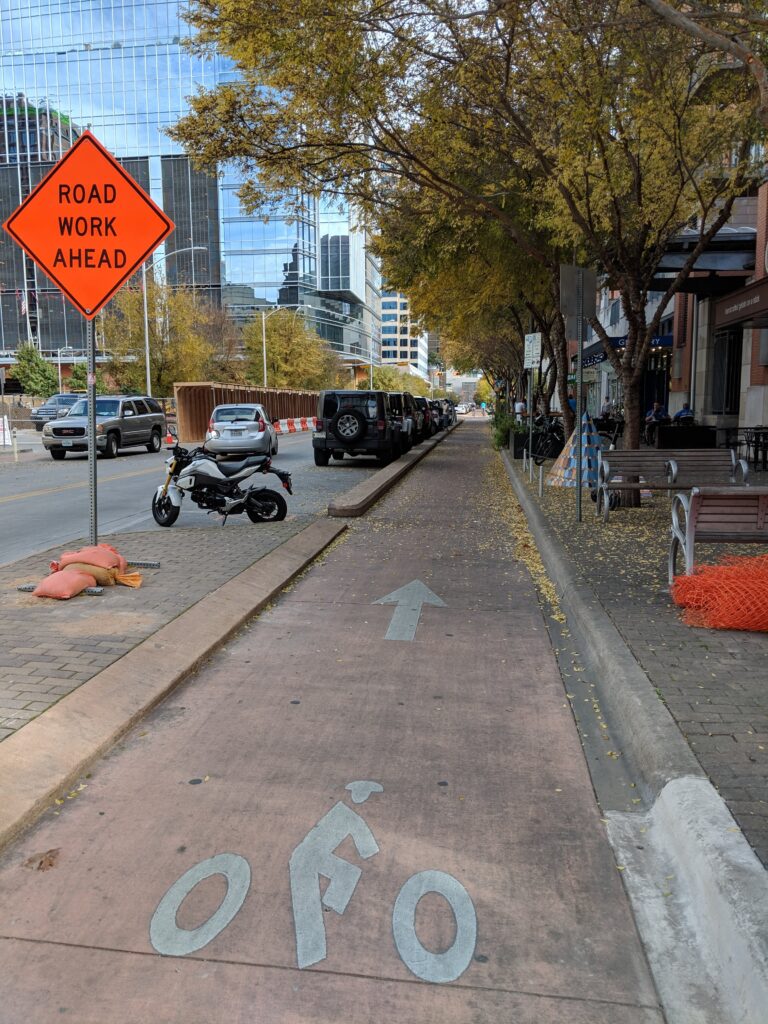In an age of polarizing issues, there has been perhaps no issue more polarizing than the deployment of shared dockless scooters. Any news article or twitter mention of them rapidly fills up with tales of people’s hatred and love for the little rideable devices. The lovers — myself very much included — sometimes (always) like to deflect from the problems with scooters by making detailed thoughtful arguments (snarky memes) about how they’re at least better than cars.
But not today. Scooters are fun, green, dangerous, revolutionary, annoying, fantastic obstacles. The benefits are real and the problems are real. Today I’ll take a look at the downsides — and how we could fix them:
Parked scooters are sidewalk obstacles
Scooters, of course, aren’t the only problems with sidewalk obstacles. Sometimes, some overly snarky jerks on twitter contrast the fever pitch of people annoyed at sidewalk problems from scooters compared to the nonchalance with which we respond to other sidewalk problems:
But just because our sidewalks have other problems doesn’t mean scooters aren’t a problem! This is especially true for people who get around in wheelchairs or using other mobility devices, who have more difficulty avoiding or moving scooters in their walking path. As G Peters on twitter says, scooters pose an additional problem that discontinuous sidewalks don’t: they are obstructions that appear fairly randomly and hence can’t be planned around.
In Austin, there have been some good efforts at educating users on safe, legal, non-obstructive places to park scooters. But as long as most of our sidewalks are relatively narrow, it’s going to be hard to find places to park scooters on the sidewalk. Fortunately, we have large amounts of our streets dedicated to vehicle parking. A simple, no-fuss solution to most scooter parking issues is to designate some of that on-street parking space for parking scooters, bikes, and whatever other small vehicles are coming in the future:
This parking spot is pretty snazzy, but you don’t need bike lanes to make it work. Simply designating a parking spot per block for scooters could easily solve this problem. After all, way more scooters can fit in a parking space than cars.
Scooters mix poorly with cars and with pedestrians
Scooters, like bikes, are in-between vehicles. They’re faster and weightier than somebody walking but slower than a car, with less protection to the driver. As a result, scooter riders (myself included) ride them on both sidewalks and streets, not quite fitting in with either. Drivers can feel annoyed stuck behind someone not going as fast as they want to go or people, um, “dicking around.”
Alternately, when people ride scooters on sidewalks, pedestrians can be annoyed by having somebody zoom by them or pass them in close quarters. I’ve heard some scooter riders pooh-pooh this sentiment (especially when the sentiment is attached to wishes to ban scooters altogether). But the same crash that may have been funny to me 15 years ago could cause me greater injury today and I imagine that it would be devastating for me in another 30 years.
There are three classes of solutions to this issue, all based on street design:
- Design the walking path to make sharing between scooter riders and pedestrians safer and more comfortable. This can be done using shared use path ideas.
- Make the driving path better for sharing between scooter riders and car drivers. Streets like Second Street work well for this: two relatively narrow lanes and a little bit of natural chaos in the form of on-street parking to make car drivers more vigilant.
- Make separate, between-speeds lane for scooter and bike riders.
Different places are going to require different solutions, but the key thing is that we have lots of devices for going around a city at 10-15 mph, we have lots of people who want to get around a city using them, and now we need to have a city that enables that to happen comfortably.

Scooters are dangerous to their riders
This particular trope drives many scooter-lovers crazy. “Sooner or later somebody’s going to be killed riding one of these things,” people say, as if driving cars wasn’t an enormous cause of death. (The first fatal incidents involving somebody on a scooter have happened in Cleveland and Washington, DC.)
But one of the things about scooter injuries that has surprised me is not the potential for devastating consequences where scooters are met by cars, but rather the number of injuries scooter riders have sustained without coming into conflict with any other vehicles. I’m not super familiar with the mechanics of bike design and safety, but people who are say that there are some obvious tweaks that could be made to the size of the wheels, the angles of the handlebars, the height of the platform, etc, to reduce the injury rate.
I understand the instinct to defend scooters. They’re fun, they’re useful, they’ve been a big help for me to live car-free. But crashes are real and injuries are bad and the ones we hurt most by putting our heads in the sand are those of us who ride.
So to the scooter lovers: let’s not deny the problems. Let’s fix them. And to the scooter haters: please get used to the fact that bikes and scooters are here to stay. The answer to your issues isn’t banning them; it’s solving the conflicts.
